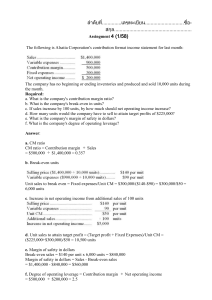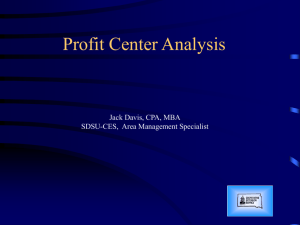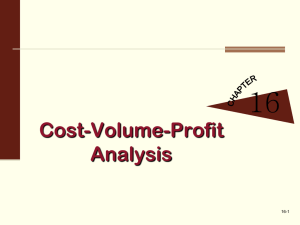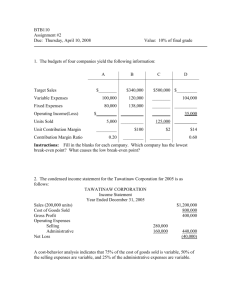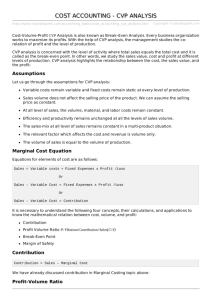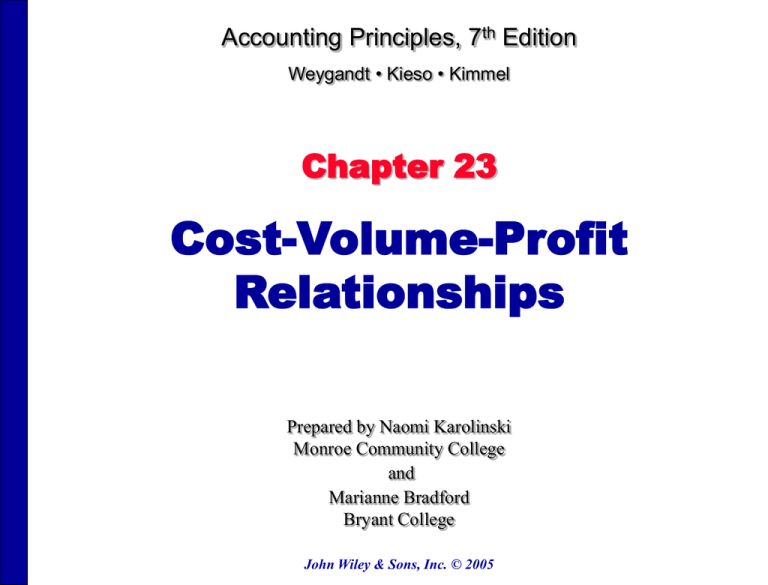
Accounting Principles, 7th Edition
Weygandt • Kieso • Kimmel
Chapter 23
Cost-Volume-Profit
Relationships
Prepared by Naomi Karolinski
Monroe Community College
and
Marianne Bradford
Bryant College
John Wiley & Sons, Inc. © 2005
CHAPTER 23
COST-VOLUME-PROFIT RELATIONSHIPS
After studying this chapter, you should be able to:
1
2
3
4
Distinguish between variable and fixed costs.
Explain the significance of the relevant range.
Explain the concept of mixed costs.
List the five components of cost-volume-profit
analysis.
5 Indicate what contribution margin
is and how it may can expressed.
CHAPTER 23
COST-VOLUME-PROFIT RELATIONSHIPS
After studying this chapter, you should be able to:
6 Identify the three ways to determine the break-even
point.
7 Define margin of safety and give the formulas for
computing it.
8 Give the formulas for determining sales required to
earn target net income.
9 Describe the essential features of a
cost-volume-profit income statement.
COST BEHAVIOR ANALYSIS
• Cost behavior analysis is the study of how specific
costs respond to changes in the level of business
activity.
• The starting point in cost behavior analysis is
measuring the key business activities.
• Activity levels may be expressed in terms of
1) sales dollars – in a retail company,
2) miles driven – in a trucking company,
3) room occupancy – in a hotel, or
4) number of customers called on – by a salesperson.
• The activity index identifies the activity that causes
changes in the behavior of costs.
BEHAVIOR OF TOTAL AND UNIT
VARIABLE COSTS
Study Objective 1
•Variable costs are costs that vary in total directly and proportionately with
changes in the activity level. A variable cost may also be defined as a cost
that remains the same per unit at every level of activity. Damon Company
manufactures radios that contain a $10 digital clock.
•The activity index is the number of radios produced. As each radio is
manufactured, the total cost of the clocks increases by $10.
BEHAVIOR OF TOTAL AND UNIT
FIXED COSTS
•Fixed costs are costs that remain the same in total regardless of
changes in the activity level. Since fixed costs remain constant in total
as activity changes, therefore fixed costs per unit vary inversely with
activity.
•Damon Company leases all of its productive facilities at a cost of
$10,000 per month. Total fixed costs of the facilities will remain
constant at every level of activity.
NONLINEAR BEHAVIOR OF
VARIABLE AND FIXED COSTS
Study Objective 2
•A straight-line relationship does not usually exist for variable costs throughout
the entire range of activity.
•In the real world, the relationship between variable cost behavior and change
in the activity level is often curvilinear, as shown in part a on the right. The
behavior of total fixed costs through all levels of activity is shown in part b.
LINEAR BEHAVIOR WITHIN
RELEVANT RANGE
The relevant range of the activity index is the range over which
a company expects to operate during a year. Within this range,
a straight-line relationship normally exists for both fixed and
variable costs.
BEHAVIOR OF A MIXED COST
Study Objective 3
Mixed costs contain both variable and fixed cost elements. Mixed
(semivariable) costs change in total but not proportionately with changes
in the activity level. Local rental terms for a 17-foot U-Haul truck,
including insurance, are $50 per day plus $.50 per mile. The per diem
charge is a fixed cost with respect to miles driven, while the mileage
charge is a variable cost. The graphic presentation of the rental cost for
a one-day rental is shown on the right.
FORMULA FOR VARIABLE COST PER
UNIT USING HIGH-LOW METHOD
•
•
•
•
•
In CVP analysis, it is assumed that mixed costs must be classified
into their variable and fixed components.
Firms usually ascertain variable and fixed costs on an aggregate
basis at the end of a time period, using the company’s past
experience with the behavior of the mixed cost at various activity
levels.
The high-low method uses the total costs incurred at the high and
low levels of activity.
The steps in calculating fixed and variable costs under this method
are as follows:
1) Determine variable cost per unit from the following formula:
Change in
Total Costs
÷
High minus Low
Activity Level
=
Variable Cost
per Unit
ASSUMED MAINTENANCE COSTS
AND MILEAGE DATA
Assume that Metro Transit Company has the maintenance
costs and mileage data for its fleet of buses over a 4-month
period as shown below. The high and low levels of activity are
50,000 miles in April and 20,000 miles in January. The
maintenance costs at these 2 levels are $63,000 and $30,000,
respectively. The difference in maintenance costs is $33,000
($63,000 – $30,000) and the difference in miles is 30,000
(50,000 – 20,000). Therefore, variable cost per unit for Metro
Transit Company is $1.10 ($33,000 / 30,000).
Month
January
February
Miles
Total
Driven Cost
Month
20,000 $ 30,000 March
40,000 48,000 April
Miles
Total
Driven Cost
35,000 $ 49,000
50,000 63,000
HIGH-LOW METHOD COMPUTATION
OF FIXED COSTS
Determine the fixed cost by subtracting the total variable cost
at either the high or low activity level from the total cost at that
activity level.
For Metro Transit Company, the calculations are as follows:
Total cost
Less: Variable costs
50,000 X $1.10
20,000 X $1.10
Total fixed costs
Activity Level
High
Low
$ 63,000 $ 30,000
55,000
$ 8,000
22,000
$ 8,000
Variable costs are costs that:
a. vary in total directly and proportionately with changes in
the activity level.
b. remain the same per unit at every activity level.
c. Neither of the above.
d. Both (a) and (b) above.
Chapter 23
Variable costs are costs that:
a. vary in total directly and proportionately with changes in
the activity level.
b. remain the same per unit at every activity level.
c. Neither of the above.
d. Both (a) and (b) above.
Chapter 23
CVP ANALYSIS
Study Objective 4
• Cost-volume-profit (CVP) analysis is the study of
the effects of changes of costs and volume on a
company’s profits.
• Cost-volume-profit (CVP) analysis is important
in profit planning.
• It also is a critical factor in management
decisions.
COMPONENTS OF CVP
ANALYSIS
The following assumptions underlie each CVP analysis:
1 The behavior of both costs and revenues is linear
throughout the relevant range of the activity index.
2 All costs can be classified as either variable or fixed with
reasonable accuracy.
3 Changes in activity are the only factors that affect costs.
4 All units produced are sold.
5 When more than one type of product is sold, the sales mix
will remain constant. Sales mix complicates CVP
analysis because different products will have different
cost relationships.
COMPONENTS OF CVP
ANALYSIS
FORMULA FOR AND
COMPUTATION OF
CONTRIBUTION MARGIN
Study Objective 5
• Contribution margin (CM) is one of the key
relationships in CVP analysis and is the amount of
revenue remaining after deducting variable costs.
• Vargo Video Company sells 1,000 VCRs in one
month, sales are $500,000 (1,000 X $500) and
variable costs are $300,000 (1,000 X $300).
• Thus, CM is $200,000 computed as follows:
Sales
$500,000
–
–
Variable Costs
$300,000
=
=
Contribution
Margin
$200,000
ASSUMED SELLING PRICE AND
COST DATA FOR VARGO VIDEO
• In CVP analysis applications, the term cost
includes manufacturing costs plus selling and
administrative expenses.
• Relevant data for the videocassette recorders
(VCRs) made by Vargo Video Company are as
follows:
Unit selling price
Unit variable costs
Total monthly fixed costs
$
500
300
200,000
FORMULA FOR
CONTRIBUTION MARGIN PER UNIT
• The contribution margin is then available to
cover fixed costs and to contribute income for
the company.
• The formula for contribution margin per unit is
shown below.
• At Vargo Video Company, the contribution
margin per unit is $200 ($500 – $300).
Unit Selling
Price
–
Unit Variable
Costs
=
Contribution
Margin per Unit
FORMULA FOR
CONTRIBUTION MARGIN
RATIO
• Others prefer to use contribution margin ratio.
•
•
The formula for contribution margin ratio is
shown below.
At Vargo Video Company, the contribution
margin ratio is 40% ($200 ÷ $500).
Contribution
Margin per Unit
÷
Unit Selling
Price
=
Contribution
Margin Ratio
BREAK-EVEN EQUATION
Study Objective 6
• The break-even point is the second key relationship
in CVP analysis and is the level of activity at which
total revenues equal total costs – both fixed and
variable.
• The break-even point can be:
1 Computed from a mathematical equation.
2 Computed by using contribution margin.
3 Derived from a cost-volume-profit (CVP) graph.
• The equation for break-even sales is:
Break-even
Sales
=
Variable Costs
÷
Fixed Costs
COMPUTATION OF BREAK-EVEN
POINT IN DOLLARS
•The break-even point in dollars can be determined by
expressing variable costs as a percentage of unit selling price.
•For Vargo Video Company, the percentage is 60% ($300 ÷
$500). The calculation is: X = .60X + $200,000
.40X = $200,000
X = $500,000
where: X = sales dollars at the break-even point
.60X = variable costs as a percentage of unit selling price
$200,000 = total fixed costs
•Therefore, sales must be $500,000 for Vargo Video Company to
break even.
COMPUTATION OF BREAKEVEN POINT IN UNITS
The break-even point in units can be calculated directly from
the mathematical equation by using unit selling prices and unit
variable costs. The calculation is: $500X = $300X + $200,000
$200X = $200,000
X = 1,000 units
where: $500X = unit selling price x sales volume
$300X = variable cost per unit x sales volume
$200,000 = total fixed costs
Thus, Vargo Video Company must sell 1,000 units to break even
BREAK-EVEN PROOF
The accuracy of the
calculations can be
proved as follows:
Sales (1,000 X $500)
Total costs:
Variable (1,000 X $300)
Fixed
Net income
$ 500,000
$ 300,000
200,000
500,000
$
–0–
FORMULA FOR BREAK-EVEN POINT
IN UNITS USING CONTRIBUTION
MARGIN
• Since contribution margin equals total revenues less
variable costs, at the break-even point, contribution
margin must equal total fixed costs.
• On the basis of this relationship, we can compute the
break-even point by using either the contribution
margin per unit or the contribution margin ratio.
• When the contribution margin per unit is used, the
formula to calculate the break-even point in units is:
Fixed Costs
÷
Contribution
Margin per Unit
=
Break-even
Point in Units
FORMULA FOR BREAK-EVEN POINT
IN DOLLARS USING CONTRIBUTION
MARGIN RATIO
• For Vargo Video Company, the contribution margin per
unit is $200.
• Thus, the break-even point in units is calculated to be:
1,000 units ($200,000 ÷ $200).
• When the contribution margin per ratio is used, the
formula to calculate the break-even point in dollars is
shown below.
• Since Vargo Video Company’s contribution margin ratio
is 40%, the break-even point in dollars is calculated to
be: $500,000 ($200,000 ÷ 40%).
Fixed Costs
÷
Contribution
Margin Ratio
=
Break-even
Point in Dollars
GRAPHIC
PRESENTATION
• An effective way to find the break-even point is to prepare a
break-even graph.
• The graph is referred to as a cost-volume-profit (CVP) graph since
it shows costs, volume, and profits.
• The construction of the graph, using the Vargo Video Company
data, is as follows:
1 Plot the total revenue line starting at the zero activity level.
2 Plot the total fixed cost by a horizontal line.
3 Plot the total cost line. This starts at the fixed cost line at zero
activity.
4 Determine the break-even point from the intersection of the
total cost line and the total revenue line.
CVP GRAPH
In the graph below, sales volume is recorded along the horizontal axis. This
axis needs to extend to the maximum level of expected sales. Both total
revenues (sales)and total costs (fixed plus variable) are recorded on the
vertical axis.
The CVP income statement classifies costs
and expenses:
a. by function.
b. as selling and administrative.
c. as variable or fixed.
d. as operating or nonoperating.
Chapter 23
The CVP income statement classifies costs
and expenses:
a. by function.
b. as selling and administrative.
c. as variable or fixed.
d. as operating or nonoperating.
Chapter 23
FORMULA FOR MARGIN OF
SAFETY IN DOLLARS
Study Objective 7
• The margin of safety is another relationship that may be
calculated in CVP analysis
• It is the difference between actual or expected sales and
sales at the break-even point.
• It may be expressed in dollars or as a ratio.
• The formula for determining the margin of safety in
dollars is shown below.
• Given that Vargo Video Company’s actual (expected)
sales are $750,000, the margin of safety in dollars is
calculated to be: $250,000 ($750,000 – $500,000).
Actual (Expected)
Sales
–
Break-even
Sales
=
Margin of Safety
in Dollars
FORMULA FOR
MARGIN OF SAFETY
RATIO
The formula and calculation
for determining the margin
of safety ratio are:
Margin of Safety
in Dollars
$250,000
÷
÷
Actual (Expected)
Sales
$750,000
=
=
Margin of Safety
Ratio
33%
FORMULA FOR REQUIRED
SALES TO MEET TARGET
NET INCOME
Study Objective 8
• By adding a factor for target net income to the
break-even equation, we obtain the formula below
for determining required sales.
• Required sales may be expressed either in sales
dollars or sales units.
• Assuming that target net income is $120,000 for
Vargo Video Company, the required sales dollars
are calculated to be: $800,000 ([$200,000 +
$120,000] ÷ .40).
Required
Sales
=
Variable
Costs
+
Fixed
Costs
+
Target Net
Income
FORMULA FOR REQUIRED SALES
IN DOLLARS USING CONTRIBUTION
MARGIN RATIO
• The sales required to meet target income can be
calculated in either dollars or units.
• For Vargo Video Company, the required sales
dollars are calculated to be: $800,000 ($320,000 ÷
40%).
• The sales volume in units at the targeted income
level is 1,600 units ($800,000 ÷ $500).
Fixed Costs +
Target Net Income
÷
Contribution
Margin Ratio
=
Required
Sales
ORIGINAL VCR
SALES AND COST
DATA
• Business conditions change rapidly and management
must respond intelligently to these changes. CVP analysis
can help.
• The original VCR sales and cost data for Vargo Video
Company are shown below.
Unit selling price
Unit variable cost
Total fixed costs
Break-even sales
$
500
$
300
$ 200,000
$ 500,000 or 1,000 units
COMPUTATION OF
BREAK-EVEN SALES IN
UNITS
Case I. A competitor is offering a 10% discount on the selling price of its
VCRs. Management must decide whether or not to offer a similar discount.
Question: What effect will a 10% discount on selling price have on the
break-even point for VCRs?
Answer: A 10% discount on selling price reduces the selling price per unit to
$450 [$500 – ($500 X 10%)]. Variable cost per unit remains unchanged at
$300. Therefore, the contribution margin per unit is $150. Assuming no
change in fixed costs, break-even sales are 1,333 units, calculated as follows:
Fixed Costs
÷
Contribution Margin per Unit
=
Break-even Sales
$ 200,000
÷
$ 150
=
1,333 units (rounded)
COMPUTATION OF BREAK-EVEN
SALES IN UNITS
Case II. To meet the threat of foreign competition, management invests
in new robotic equipment that will lower the amount of direct labor
required to make the VCRs. It is estimated that total fixed costs will
increase 30% and that variable cost per unit will decrease 30%.
Question: What effect will the new equipment have on the sales volume
required to break even?
Answer: Total fixed costs become $260,000 [$200,000 + ($200,000 X
30%)], and variable cost per unit is now $210 [$300 – ($300,000 X 30%)].
The new break-even point is 900 units:
Fixed Costs
÷
Contribution Margin per Unit
=
Break-even Sales
$ 260,000
÷
($500 – $210)
=
900 units (rounded)
COMPUTATION OF
REQUIRED SALES
Case III. An increase in the price of raw materials will increase the unit
variable cost of VCRs by an estimated $25. Management plans a cost-cutting
program that will save $17,500 in fixed costs per month. Vargo Video
Company is currently realizing monthly net income of $80,000 on sales of 1,400
VCRs.
Question: What increase in sales will be needed to to maintain the same level
of net income?
Answer: The variable cost per unit increases to $325 ($300 + $25), and fixed
costs are reduced to $182,500 ($200,000 – $17,500). Because of the change in
variable cost, the variable cost becomes 65% of sales ($325 ÷ $500). Using the
equation for target net income, required sales are calculated to be $750,000, as
follows:
Required Sales
= Variable Costs + Fixed Costs + Target Net Income
X =
.65X
.35X =
$262,500
X =
$750,000
+
$182,500
+
$80,000
ASSUMED COST AND EXPENSE
DATA
Study Objective 9
• The CVP income statement classifies costs and expenses
as variable or fixed and specifically reports contribution
margin in the body of the statement.
• Assume that Vargo Video Company reaches its target
net income of $120,000.
• The following information is obtained on the $680,000 of
costs that were incurred in June:
Cost of goods sold
Selling expenses
Administrative expenses
Variable
Fixed
Total
$ 400,000 $ 120,000 $ 520,000
60,000
40,000
100,000
20,000
40,000
60,000
$ 480,000 $ 200,000 $ 680,000
CVP INCOME
STATEMENT
•
•
Net income is $10,000 in both
statements.
The major difference is the format for
the expenses.
TRADITIONAL VERSUS CVP
INCOME STATEMENT
VARGO VIDEO COMPANY
Income Statement
For the Month Ended June 30, 2005
CVP Format
Traditional Format
Sales
Cost of goods sold
Gross profit
Operating expenses
Selling expenses
Administrative expenses
Total operating expenses
Net income
$ 800,000
520,000
280,000
$ 100,000
60,000
160,000
$ 120,000
Sales
Variable expenses
Cost of goods sold
Selling expenses
Administrative expenses
Total variable expenses
Contribution margin
Fixed expenses
Cost of goods sold
Selling expenses
Administrative expenses
Total fixed expenses
Net income
$ 800,000
$ 400,000
60,000
20,000
480,000
320,000
120,000
40,000
40,000
200,000
$ 120,000
COPYRIGHT
Copyright © 2005 John Wiley & Sons, Inc. All rights reserved. Reproduction
or translation of this work beyond that permitted in Section 117 of the 1976
United States Copyright Act without the express written consent of the
copyright owner is unlawful. Request for further information should be
addressed to the Permissions Department, John Wiley & Sons, Inc. The
purchaser may make back-up copies for his/her own use only and not for
distribution or resale. The Publisher assumes no responsibility for errors,
omissions, or damages, caused by the use of these programs or from the use
of the information contained herein.

